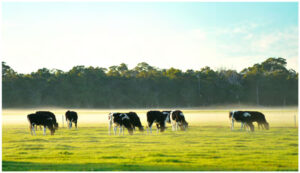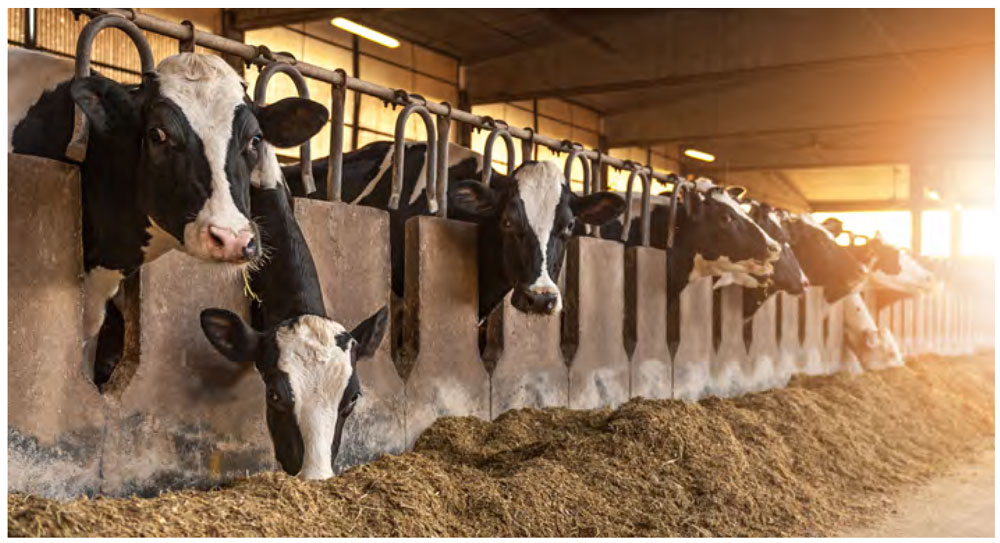Click here to view as a pdf: The Elegance and Wisdom of Simplicity Part II
Preface: This is the second part of a two-part article addressing my thoughts about common sense strategies for dairy nutrition. The first article can be found at: https://crystalcreeknatural.com/wp-content/uploads/2021/03/The-Elegance-And-Wisdom-Of-Simplicity.pdf
The Important Role of Simplicity
In part 1 of this article (published in the April 2021 Crystal Creek® Newsletter), I talked about the important role of simplicity and how complex science needs to adhere to simple, basic and sound principles so information can be easily and efficiently applied with balance. If the concept of simplicity is not paramount, it is easy to lose perspective and forget what we have learned through decades of feeding animals. Simplicity also helps us deal with the overwhelming sea of data. Information that is consistent with simple principles will advance a cohesive and efficient strategy that helps us reach a sustainable goal.
Has the Dairy Nutrition Industry Lost Its Way?
In part 1 of this article I reflected on how, from my perspective, the dairy industry has lost its way. I believe the dairy nutrition industry in large part has over-focused on maximizing gross profit, i.e., milk production, and has lost track of the more important goal of sustainable, optimum net profit on the dairy farm as defined by a focus on improving lifetime milk production from a cow. I gave several examples of past attempts in the dairy industry that failed in large part because they did not pay attention to simple principles. In addition to employing easy hindsight to past failures, it is important to apply simple principles to what is still being used today in the dairy nutrition industry. We must recognize the shortcomings and lack of cohesive strategy in current practices.
Simple and Wise Principles that Stand the Test of Time
Having been in the livestock nutrition industry for 47 years now, I find it fascinating to reflect on how much science we have learned in dairy nutrition since I started in 1974. However, some foundational principles seem to have faded from the industry’s collective memory. To illustrate my point, consider some of these simple adages:
- Feed a cow like a cow.
- There is no good substitute for high-quality forages in the diet.
- Listen to the cows, they will not lie.
- That old cow made me money.
- It is hard to be efficient with inefficient tools.
- Feed the ruminal microbes, and they will feed the cow.
- Do not fight Mother Nature, work with her.
- Whatever you do, don’t make it worse.
It is not about how much money you make, but rather how much money you can keep.
The time-honored principles of feeding a cow like a cow, at times, have been passed over and traded for the newest industry fad.
Products and Concepts
The following products and concepts that are still in use today, are ones I believe are not needed, based on sound biological principles, common sense, simplicity and good economics in dairy nutrition:
Rumen Protected Amino Acids: With the proper diet, ruminants are already capable of meeting, and exceeding, amino acid requirements. The focus should be on the cow utilizing its current dietary amino acids, not on feeding more in the form of rumen-protected amino acids. Return on investment is very questionable.
Anionic Salts: If the proper forages are fed to a dry cow, anionic salts are not needed. They are expensive, unpalatable and inappropriate to be fed in a dry cow diet.
Straw: To me, feeding straw is comparable to feeding plastic to a ruminant. It is a crutch to feeding an inappropriate and poorly designed ruminant diet. It makes the paper values look good in high grain diets, but ignores the biological principles of sustainable dairy cow health and production.
Calcium Binders in Dry Cow Diets: Feeding an inappropriately high calcium diet to a dry cow and then adding a calcium binder lacks common sense. With planning, it is not that hard to use the proper feedstuffs to balance cations in a dry cow diet. Calcium binders are not needed.
Ionophores in Dry Cow, Lactating Cow and Heifer Diets: Ionophores are removed from all Crystal Creek® dairy diets, and are not missed. Our focus is on improving the utilization of homegrown forages to which ionophores are counter-productive. Ionophores kill some fiber digesting ruminal microbes in favor of starch digesting microbes. Also, if an objective person would read an ionophore label (which admits to reducing reproductive performance, milk components and dry matter intake), the question of why would anyone feed an ionophore to a dairy animal is inevitable. The amount of ionophores used in the U.S.A. dairy industry is a classic example of powerful marketing vs. sound common sense and simple principles of a sustainable dairy cow industry.
Antibiotics in Calf Milk Replacers: For some, it is thought to be ‘impossible’ to raise dairy calves without heavy reliance on antibiotics. This is simply not true. There are a number of good management practices that can significantly reduce the need for antibiotic use, i.e., good ventilation, immune-supportive nutrition and proper sanitation. After applying good sanitation, management and immune support, there are a number of strategic nutritional alternatives that research has shown to warrant a first consideration before antibiotics.
Low Performance and/or Counter-Productive Nutritional Ingredients: Examples like cottonseed, straw, clay, kelp, diatomaceous earth, humates, charcoal, and peat moss. If any of the simple principles listed at the start of this article were applied, it would be difficult, or impossible to justify the use of these ingredients in a dairy ration.
Electrolytes for Lactating Dairy Cows: University research has shown that electrolytes fed to lactating dairy cows experiencing heat stress had zero benefits to the cow on all health and performance metrics that were monitored.
Probiotics to Support Intestinal Function in Excessively High Starch Diets: There are some probiotics that function in the intestinal tract of a cow and help to reduce the risk of pathogens, intestinal tissue degradation and poor nutrient utilization when feeding a high grain, acidotic ration. The question I ask is, why bother to feed the acidotic ration to begin with? An acidotic ration does not optimize return on investment, cow health, nor production. Adding a probiotic to a seriously flawed nutritional strategy seems to me to be lacking common sense.
No Grain/Only Milk and Hay Calf Raising: This is a classic example of politically correct livestock nutrition currently found in niche industries that has nothing to do with biological facts. This practice has been shown to be detrimental to organ development of the calf, calf growth and subsequently to the cow’s production for the rest of her life. Calves need grain to maximize organ development.
All Grain/No Forage Calf and Young Heifer Diets: These diets are a classic example of laziness that accommodates the poorly designed animal handling restrictions of large dairy operations that house animals for the convenience of feed handling, and not the optimum biological benefit and development of the animal. Young heifers should eat hay and forages.
Growth Hormone for Lactating Dairy Cows: I have seen herds that have gone off of injectable growth hormone due to market pressure and do not miss the concept on a business level.
Biotin: Typically, biotin is only needed in acidotic dairy rations due to impaired rumen function where the cow cannot produce enough biotin on its own. Again, why feed a cow an acidotic ration in the first place? Biologically and economically acidotic rations lack common sense.
Mycotoxin Binders Without Enzyme Support Formulation: Mycotoxins are a common fact of life in the global grain supply. Some important mycotoxins cannot be bound up without incorporating an enzyme to partially degrade the mycotoxin first, i.e., vomitoxin. Old school mycotoxin binders like clays lack species-specific enzymes and are obsolete. In fact, they can actually be counter-productive to good nutrition.
Buffers: Products like sodium bicarbonate are only needed in acidotic diets, and/or high-stress conditions, i.e., heat stress, sorting. Why feed an acidotic ration to begin with? Properly formulated dairy rations can help cows better cope with heat stress and reduce sorting. It is typical for Crystal Creek® dairy herds to have very good milk components and production, even in the summer, without the use of a buffer like sodium bicarbonate.
Reproductive Hormones: The question should be asked, why isn’t the cow reproducing properly? The cow should be biologically supported with proper nutrition and reduced stress, so she can naturally cycle and reproduce. In many cases where cows do not cycle, hormones will not help. It lacks common sense to try to synchronize something that is not happening. Also, I believe that, not unlike the growth hormones in dairy, once the public realizes the amount of reproductive hormone use in the dairy industry, there will be a market backlash against their use, and/or against the consumption of dairy products.
Corn Silage: Ask yourself some basic questions about corn silage. Why do we feed it? Yes, more tonnage per acre, and more cows fed per acre. However, the flip side of the corn silage coin is that a corn silage diet is also a higher-cost diet due to the need to purchase more off the farm protein. A little corn silage is OK, and maybe it is necessary in some poor cropping years. However, I have found that it tends to be more profitable for dairy producers to feed less corn silage, or possibly no corn silage. The feed industry may not have as many protein sales, but I believe the dairyman would make more money.
Rumen Protected (By-Pass) Fats: Even though by-pass fats do not melt in the rumen and reduce fiber digestion, the liver still needs to cope with this fat in the diet which is very difficult at key times of lactation. For example, it has been shown that cows should not be fed fat during early lactation (the liver is already struggling with excess fat off the back), nor during warm weather due to low digestibility. It is better to remove the fat from the diet, support rumen and liver function and improve dry matter intake to get more energy into the cow. I see by-pass fat as becoming merely a commodity, with decreasing use in dairy rations.
How Did We Get Where We Are Today Vs. the Good Old Days
I do not know for sure how the dairy industry arrived at this point, but I believe it is partially due to taking an eye off the bigger picture of net profit (profit after expenses/return-on-investment). This is caused by being distracted by the allure of gross profit (total milk production), which is easier to monitor, and demands less accountability to a sustainable business model, as well as drifting away from the simple foundational principles of good dairy nutrition and a profitable dairy business model.
I believe that focusing on a goal to achieve the best lifetime production for dairy cows is a smart business model for the dairy producer. It brings cow longevity into the formula and would require new rules for a biologically supportive nutritional strategy and a different attitude towards a more sustainably managed dairy cow. What is needed are healthier guidelines that are more biologically aware and compatible. For example, the highest milk production occurs in cows during their 4th, 5th and 6th lactation. Much of the U.S.A. dairy industry today seems to be attempting to force first and second lactation cows to milk like 4th, 5th and 6th lactation cows before they are biologically ready. The result is higher feed costs, reduced cow health, decreased longevity, poorer reproductive performance, higher cull rates and less profitability for the producer. The genetic industry truly benefits from a 40% to 50% annual culling rate, but I doubt the farmer does. Goals and management styles that target a cow to produce 150,000 to 200,000 lb. per lifetime means the cow must be fed and cared for in a manner that keeps her healthy, lets her naturally reproduce and also meet these lifetime production goals. Focusing on lifetime production for a dairy cow is successfully followed in other parts of the world. We can also do it here in the United States.
I remember the days when cows were fed only dry baled hay as the forage with a ground ear corn and soybean meal-based grain mix. Granted the milk production in the good old days may have been less than now, but ‘simple’ principles were soundly in place that would have offset some of the lower production. For example, healthier cows that lived longer had higher milk production due to proper maturation of the cow (optimum production during 4th, 5th and 6th lactation), and they actually showed heat without hormone treatments. Milk components were strong and life was a bit simpler. I am not proposing that we go all the way back to the old days. However, we could and should bring some of the simple and wise principles of that time forward in order to help shed much of the financial waste the industry is experiencing. This would help us to refocus on lifetime cow production and net profit for the dairy producer. As I have indicated here, there are still many products and feeding techniques employed today that do not pass the test of simple common sense and would not fit into a smarter and more profitable business strategy for the dairy producer.
The Crystal Creek® Dairy Nutrition Model is built on key, simple, biologically sound principles of dairy nutrition that have stood the test of time. Profitable, sustainable, common sense, and simple dairy nutrition, is very achievable in today’s dairy industry. Give Crystal Creek® a call today and see for yourself.



